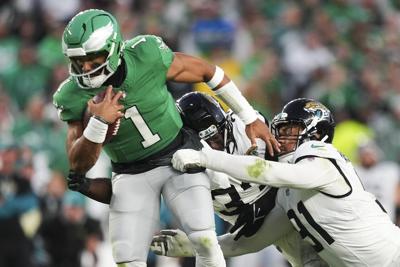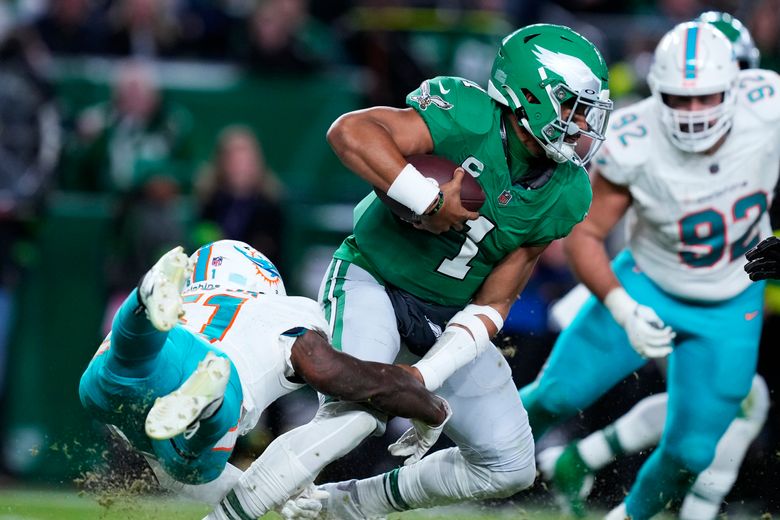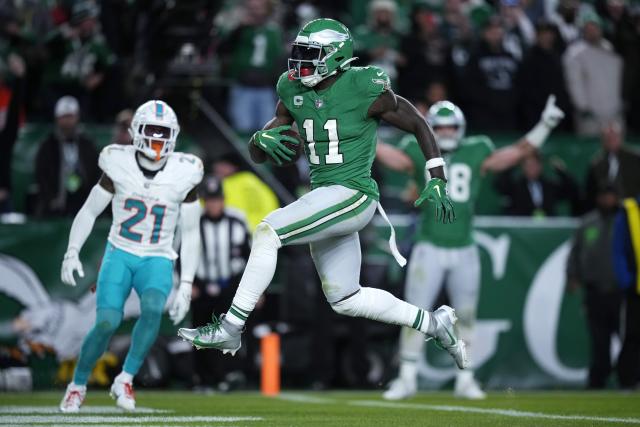Philadelphia Eagles head coach Nick Sirianni has recently praised his quarterback, Jalen Hurts, for playing well despite his statistical numbers not always reflecting his performance. This statement has sparked a debate among fans and analysts, as the question arises: Is Hurts truly playing at a high level, or is Sirianni overlooking key aspects of his game? Let’s break down the situation and evaluate whether Sirianni’s confidence in Hurts is justified.

The Stats vs. Performance Debate
When you look at the statistics, Jalen Hurts’ numbers have been up and down. While he’s had games where his passing yards and touchdowns are impressive, there are others where his performance has been less spectacular, with missed throws and inconsistent decision-making. However, the Eagles’ success as a team has often been tied to Hurts’ ability to make plays in critical moments, even if the box score doesn’t always tell the full story.
“Statistically, Hurts may not always light up the scoreboard, but there’s more to his game than just numbers,” said Sirianni in a recent press conference. “He’s been a leader for us, making big plays when it counts, and that’s what really matters.”
So, what is Sirianni seeing in Hurts that goes beyond the traditional statistics?

Hurts’ Impact Beyond the Box Score
One of the biggest things that Sirianni points to is Hurts’ leadership and poise. Hurts has been known for his ability to step up in high-pressure situations, whether it’s making a clutch run or delivering a key throw. His leadership in the locker room and on the field has been crucial in building the Eagles’ offensive success this season.
“Jalen’s a winner,” Sirianni added. “He makes plays with his legs, he’s taking care of the ball, and he does whatever it takes to keep us in the game. Those are the things that you can’t always measure with stats.”
Hurts has excelled in the intangibles—his leadership, decision-making, and ability to rally the team in tough spots. His rushing ability, in particular, adds a dimension to the Eagles’ offense that stats can’t fully capture. He’s been effective in short-yardage situations, using his strength and mobility to move the chains, and his threat as a dual-threat quarterback has kept opposing defenses on their toes.
The Growth and Development of Hurts
Another key factor that Sirianni emphasizes is Hurts’ growth from year to year. Hurts has shown significant improvement as a passer, particularly in terms of his accuracy and his ability to make reads in the pocket. Although his numbers might not always jump off the page, his development as a quarterback has been noticeable, and it has made a difference in how the Eagles’ offense operates.

“I’ve seen him grow in ways that are hard to quantify on a stat sheet,” Sirianni said. “He’s making quicker decisions, reading defenses better, and has become more confident in the passing game. That’s why he’s been so effective for us.”
Hurts’ growth as a passer has allowed the Eagles to be more versatile offensively. He’s shown an improved deep ball and has developed more chemistry with his receivers, especially A.J. Brown. This added dimension has made the Eagles a more dangerous offense overall.
The Argument for Hurts’ Continued Success
Hurts has also been a key contributor in the Eagles’ run game, and his ability to take control of the ground attack has been critical to the team’s overall success. His mobility, paired with an effective offensive line, makes him a constant threat in the red zone and on third downs. His rushing touchdowns, particularly in short-yardage situations, have been a key factor in the Eagles’ ability to control games and score when it matters most.
Moreover, Hurts’ ability to limit turnovers and maintain ball security has been another important aspect of his play that might not be fully reflected in his stats. His maturity as a quarterback is evident in his approach to decision-making, often opting to take the safe play instead of forcing a risky pass or trying to make a big play that could result in a turnover.
Criticism and the Case for More Consistency
However, not everyone is convinced that Hurts is playing at an elite level. Critics argue that while Hurts has made strides, he still struggles with consistency, especially when it comes to passing accuracy in certain situations. There are games where Hurts’ passing numbers don’t match up to the level expected from a starting quarterback in the NFL, especially in high-pressure moments where the Eagles need to rely on him to throw the ball effectively.
“Jalen Hurts is a great athlete, but there are still areas of his game that need work,” said one analyst. “He needs to be more consistent with his mechanics and his decision-making in the pocket. Until he cleans that up, he’ll remain a good quarterback, but not a great one.”
This is where the divide lies — while Hurts’ leadership, mobility, and poise under pressure are undeniable, his passing consistency is still a question mark for some. Hurts will need to continue refining his throwing mechanics and make better decisions in the pocket to fully take his game to the next level.
Conclusion: Is Sirianni Right?
Nick Sirianni’s belief in Jalen Hurts is certainly justified in many respects. Hurts is a dynamic leader who excels in making plays in critical moments, and his growth as a quarterback has been impressive. His ability to lead the Eagles to victories, both through the air and on the ground, is invaluable. However, there’s still room for growth, particularly in terms of passing consistency and accuracy.
Sirianni is right to focus on the intangibles that make Hurts a valuable player, but the question remains whether Hurts can continue to develop as a passer and elevate his game to truly elite status. If Hurts can refine his passing and become more consistent, then Sirianni’s confidence in him will be fully justified — and the Eagles will have a quarterback capable of leading them to sustained success in the postseason and beyond.







